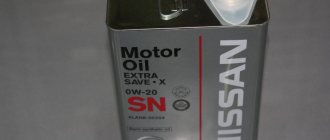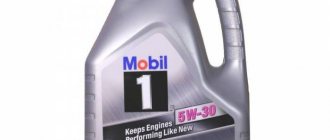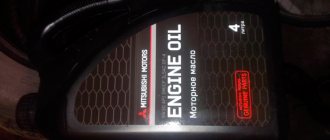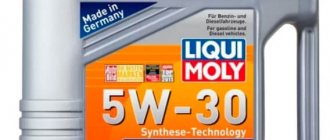With the onset of cold weather, motorists begin to wonder how to choose high-quality, reliable winter oil. An important characteristic for motor oil is viscosity. It determines how quickly the substance will be supplied to the engine and pumped back, as well as whether it will perform its duties under different conditions. The most popular oils on the market are 0w30 and 5w40. Let's figure out what the markings mean, how they differ, what oil to use for the winter and whether they can be mixed.
SAE oil classification - what's the point?
Motor lubricant is classified by viscosity by the Society of Automotive Engineers - SAE. The quality standards and norms of this European organization have long been recognized internationally. Any self-respecting manufacturer tries to meet these standards.
The SAE marking is printed on each package of motor oil for passenger cars. It is deciphered as follows:
- the number before the letter “w” (short for “winter” - winter) indicates at what minimum temperature the oil retains its fluidity for the winter;
- the number located after the letter “w” displays the maximum possible temperature at which the substance can be used without worrying that it will no longer cope with loads due to excessive fluidity.
SAE standards cover many oil characteristics. Only the main ones are listed below:
- kinematic viscosity - the ratio of dynamic viscosity to the density of the lubricant component;
- starting properties - determine what kind of resistance is created by the liquid when a cooled engine is activated, as well as whether it is possible to achieve the speed required for starting at a certain ambient temperature;
- degree of pumping - the speed of delivery of oils to the rubbing parts of the power unit during a cold start;
- viscosity at elevated temperatures - measured during excessive loads on the vehicle’s power unit.
It will be difficult for an inexperienced motorist to decipher the SAE marking. You might think that if there is a 0 in front of the “w”, then the lubricant will only work at that temperature. In fact, everything is a little different.
Rating of motor oils 0w-30
0w30 oil from different manufacturers has different characteristics. The rating will help you navigate when choosing the right product.
Shell Helix Ultra
Synthetics with a package of additives that protect the car from corrosion. Helps save up to five percent of fuel, reduces vibration of the power unit and makes it less noisy, has a stable composition and protects the car from daily load. Not suitable for diesel engines with particulate filters.
Castrol EDGE
Synthetic composition for modern power units, enriched with titanium compounds. The special Titanium FST technology guarantees maximum protection even under extreme loads. The density of the lubricant changes depending on conditions, ensuring excellent engine condition.
Motul 8100 Eco-energy
An economical synthetic product that provides protection to internal combustion engine components and evenly removes excess heat. Effective against sludge deposits, reduces the number of oxidation processes, allows you to start gasoline and diesel engines in winter. Can be mixed with products from other manufacturers.
Decoding the engine oil markings
Viscosity of winter oil at low temperatures:
- 0w – the liquid is used in the temperature range down to -35-30°C, that is, you can safely fill it for the winter;
- 5w – temperature limit up to -30-25°C;
- 10w – the liquid can withstand frosts down to -25-20°C;
- 15w – suitable for use in frosts down to -20-15°C;
- 20w – oil is intended for use at sub-zero temperatures down to -15-10°C.
High temperature viscosity indicators:
- 30 – the lubricant can withstand heat up to +20-25°C;
- 40 – the oil retains its properties at temp. environment up to +35-40°С;
- 50 – maximum temperatures up to +45-50°C;
- 60 – withstands temperatures up to +50°C.
Decoding 0W30 SAE
To make it easier for customers to choose certain lubricants, manufacturers use special markings that indicate the characteristics of the product - SAE.
The marking allows you to judge the viscosity of the lubricant composition depending on temperature. Motor oil 0w30 is a synthetic product that is recommended by various car manufacturers. The interpretation of the oil marking in this case will be as follows:
- the presence of the letter “W” in the marking means that the lubricant is used in any season - both in summer and winter;
- “0” indicates viscosity in cold weather. An engine with such a lubricant operates quietly in temperature conditions down to -35°C to -40°C;
- “30” indicates the maximum temperature threshold in the summer heat. It is +30 degrees.
The temperature in the system can reach up to 150 degrees - the lubricant can withstand this. The viscosity index of this oil is 170 units.
Oil viscosity indicators 0w30
Lubricant 0w30 is an ideal option when the ambient temperature drops significantly. This brand is considered an all-season semi-synthetic and is deciphered as follows:
- minimum temperature limit -35°C;
- maximum +25°C.
This oil can also be used in summer, but only if it is not too hot. If summer temperatures rise above the specified value, it is advisable to fill the car with a fluid with extended high-temperature viscosity.
Oil viscosity indicators 5w30
Motor lubricant 5w30 is the most popular and sought after product among car owners. Regardless of whether it is synthetic or semi-synthetic (the choice depends on the age and technical characteristics of the vehicle), this is the most suitable option for our climatic conditions. The oil indicators are as follows:
- minimum operating temperature -30°C;
- maximum +25°C.
Important! Motor oils of the above brand have unique properties. The composition contains special additives that provide enhanced protection of the power unit from wear, as well as resistance of parts to oxidation and corrosion even in unstable weather conditions (high humidity, sudden changes in day/night temperatures).
How to choose oil for your car
When choosing a lubricant for your car, you should be guided by:
- Manufacturer's recommendations.
- Climatic conditions.
- The state of the motor system.
- Mileage of the vehicle.
5w-30.
Before going to the store, you should carefully study the car's operating manual. It is in it that it is clearly stated what can be poured under the hood and what cannot. If the power plant is suitable for viscosities 0w30 or 5w30, then we move on to analyzing weather conditions.
Residents of the northern regions of the country often face the problem of difficult engine starting. It occurs due to a weak battery and inappropriate viscosity of the oil product. When choosing which oil is better to purchase - 0w30 or 5w30 - you should take into account critically possible situations. For example, if in winter the temperature outside the window drops to -35°C, then you should choose 0w30.
When a vehicle has more than a hundred thousand kilometers behind it, the condition of its propulsion system requires special care. Over a period of long-term operation, the gaps between the mechanisms increase noticeably. Regular oil passes through without lingering. Thus, the fluid cannot provide the proper level of protection against subsequent wear and overheating. This can be corrected by using a lubricant with increased viscosity. If for the first 100-120 thousand kilometers it is advisable to use a 0w30 composition, then if this indicator is exceeded, it is recommended to switch to a more viscous option - 5w30. This recommendation can be applied if it does not contradict the requirements of the car manufacturer.
What is the difference between 0w30 and 5w40 oils?
Each oil has its own distinctive feature.
The differences between 0w30 and 5w40 lubricants lie not only in the minimum temperature limit. There are many more of them, even from one manufacturer. It's all about the additives (impurities) that are added to the composition.
Additives are a kind of “tangle” of polymers. When temperatures change, this “ball” unfolds and collapses. In extreme heat, the fibers of the “ball” expand, swell and it begins to unfold. When it's cold, polymer compounds shrink and harden.
For lubricating fluid 0w30, the structure of the above-described “tangle” differs from the structure of 5w40. When the “five” already begins to freeze and turn into jelly, the “zero” will still feel great. Therefore, if you need winter, the most reliable motor oil, you should choose 0w30. And for a stuffy summer, the second option is more suitable.
Motor lubricants 0w40 or 5w40 - are there any differences?
To begin with, let’s leave aside the viscosity of both lines of oils and recognize as a constant that all lubricants have different freezing thresholds, even when specifying the standard SAE 0w40 or 5w40. In this matter, it is worth returning to the roots, namely the basic structure of motor lubricant. As has been said more than once, the quality of the working life of motor oil directly depends on its original base, which in most cases is natural, i.e. mineral with modern cleaning technologies. However, you should not think that the purification of the original product is carried out by the same company, which is called the manufacturer.
There are only about three corporations in the world that prepare base oil; they mainly purchase raw materials for further use, which means adding additives. The second type of motor oil base is considered a synthetic product obtained exclusively through synthesis at the molecular level.
By right, synthetics are always more expensive and this is not caused by additive packages, but by the fact that the oil base will never “suffer” from the problems that natural mineral oil is susceptible to.
Considering the performance of both motor lubricants - 0w40 or 5w40 - at first glance we can conclude that both lines belong to pure synthetic oils. In fact, this is not so:
- 0w40 is definitely synthetic, and this is confirmed by the increased fluidity of the oil.
- 5w40 - conditionally classified as synthetic oils, since in most cases the quality of the oil is achieved by the hydrocracking process, which means the original oil base is still mineral, as evidenced by the higher viscosity threshold in most products.
The protective properties of 0w40 and 5w40 will also differ, because initially the basic structure will be different and will impart something different to each oil.
Is it possible to mix 0w30 oil with 5w30
According to experts, mixing lubricating fluids is extremely undesirable. And all because the impurities in their composition will conflict, can enter into unpredictable chemical reactions and precipitate, which will clog engine parts. But if the situation is emergency and there are no other options, you can combine 0w30 with 5w30. The main thing is to follow the rules:
- the amount of liquid being poured should be no more than 15% (in this case, the characteristics of the previous lubricant will not change much);
- It is better to mix liquids from the same manufacturer (made from the same raw materials);
- At the first opportunity, you need to completely renew the lubricant in the engine with a full flush and replacement of the filter.
Long-term driving with a self-prepared cocktail of motor lubricants can lead to a major overhaul of the power plant, the costs of which are comparable to the purchase of a new engine.
Synthetics and semi-synthetics - what are the advantages?
Synthetic ones have the following advantages:
- Wide temperature range. It should be remembered that it constantly heats up in the engine. Often the temperature is several hundred degrees. Under such conditions, work is carried out for a very long time. Synthetics are able to work effectively under such conditions;
- Synthetic is resistant to polymerization; Synthetics ensure stable engine operation, eliminating gluing and folding of components.
- Excellent cleaning ability; As you know, it constantly passes through the engine, washing and cleaning it. Thanks to synthetics, the internal parts of the engine are flawless.
- Optimal viscosity level at 70-150 degrees; As already written above, for any engine such a characteristic as viscosity is important. Thanks to synthetic motor oil, the viscosity level is ideally maintained in the engine.
- Minimum possible evaporation. Natural evaporation occurs during operation. The amount of evaporation can be very different. For synthetics this figure is the lowest.
Good to know: The best motor oil for a gasoline engine
When considering the disadvantages of synthetics, it should be noted that they are compensated for by additives. Through additives, many additional, already positive, qualities can be achieved. How much of these qualities depends on who manufactured the lubricant. Because of this, the price may vary. At the moment there are many manufacturers of motor oils.
Semi-synthetic ones have the following advantages:
- Low cost; Compared to synthetic ones, semi-synthetics are significantly cheaper.
- Wide range of applications; Semi-synthetic ones are more widely used. They can be used in both diesel and gasoline engines.
- Low evaporation from the surface of parts; As with synthetics, semi-synthetic oils also have low evaporation rates.
- Prevents the formation of deposits. During operation, deposits may form in the engine. When using semi-synthetic oils, such deposits are prevented.
Compared to the so-called “mineral water,” semi-synthetics have much better characteristics. For this reason, if it is not possible to buy synthetic, then semi-synthetic would be the best option. This can cope with its functions perfectly. Moreover, the functionality of such oil lasts much longer.
0w30 or 5w30 – which is better?
Now we can answer the most frequently asked question: which oil is better, which one should be poured into the engine in winter. Lubricants 0w30 and 5w40 have completely different temperature limits and, therefore, properties. Therefore, it is impossible to say which is better or worse. These brands are simply different and designed for different operating conditions. Each driver determines independently which oil to use in winter.
This is interesting! Lubricants with different viscosities may be better suited to a particular type of powertrain. For example, if the engine is old and during operation, due to prolonged friction, gaps have formed between its parts, it is better to choose a more viscous oil that compensates for these defects. It will help extend the life of the vehicle and improve the performance of its engine.
It must be remembered that the longevity of the engine depends on the filled oil.
Bottom line
No matter how brightly the properties of a particular composition are described, only the liquid that is prescribed in the car’s manual should be poured into the engine. If a car manufacturer allows the use of both 0w30 and 5w30, then there is no point in “marrying” them together. There are motor oils, such as Liqui Moly, whose labels clearly state that they are miscible. You are allowed to experiment here. But also within reason, because now you know what the difference is between 0w30 and 5w30 oil.









